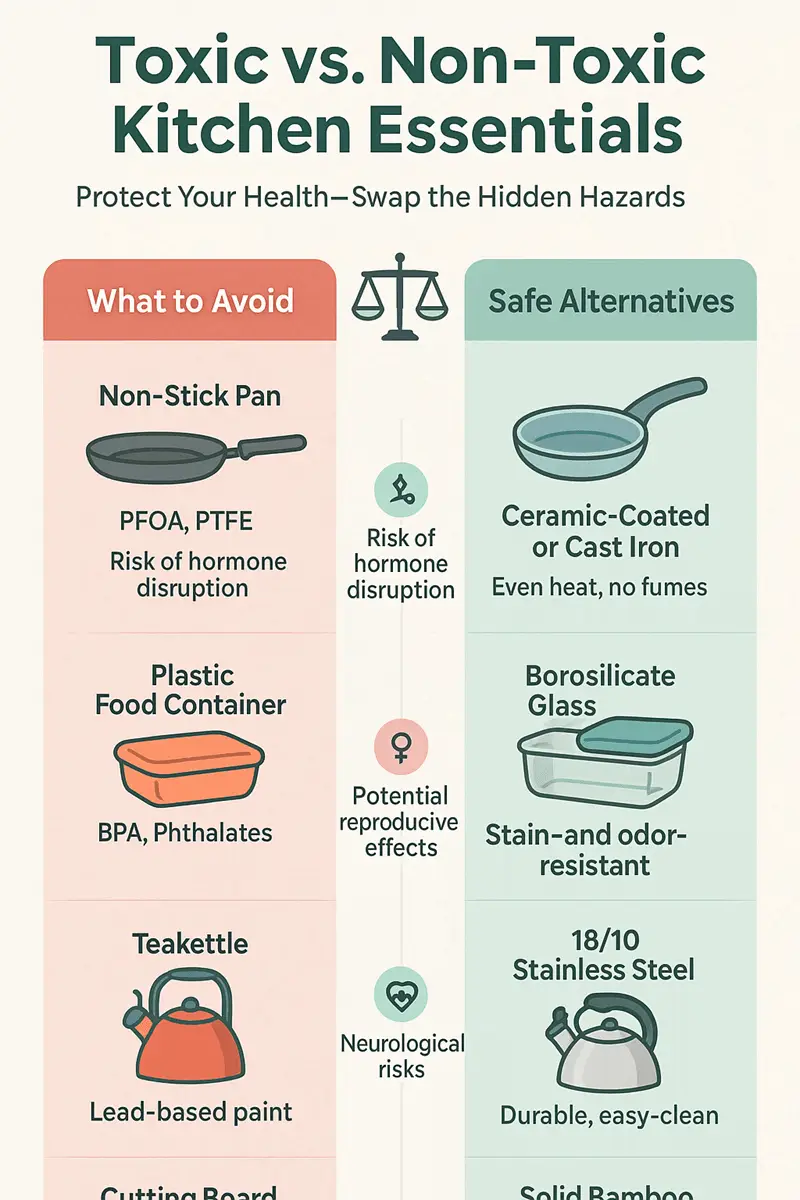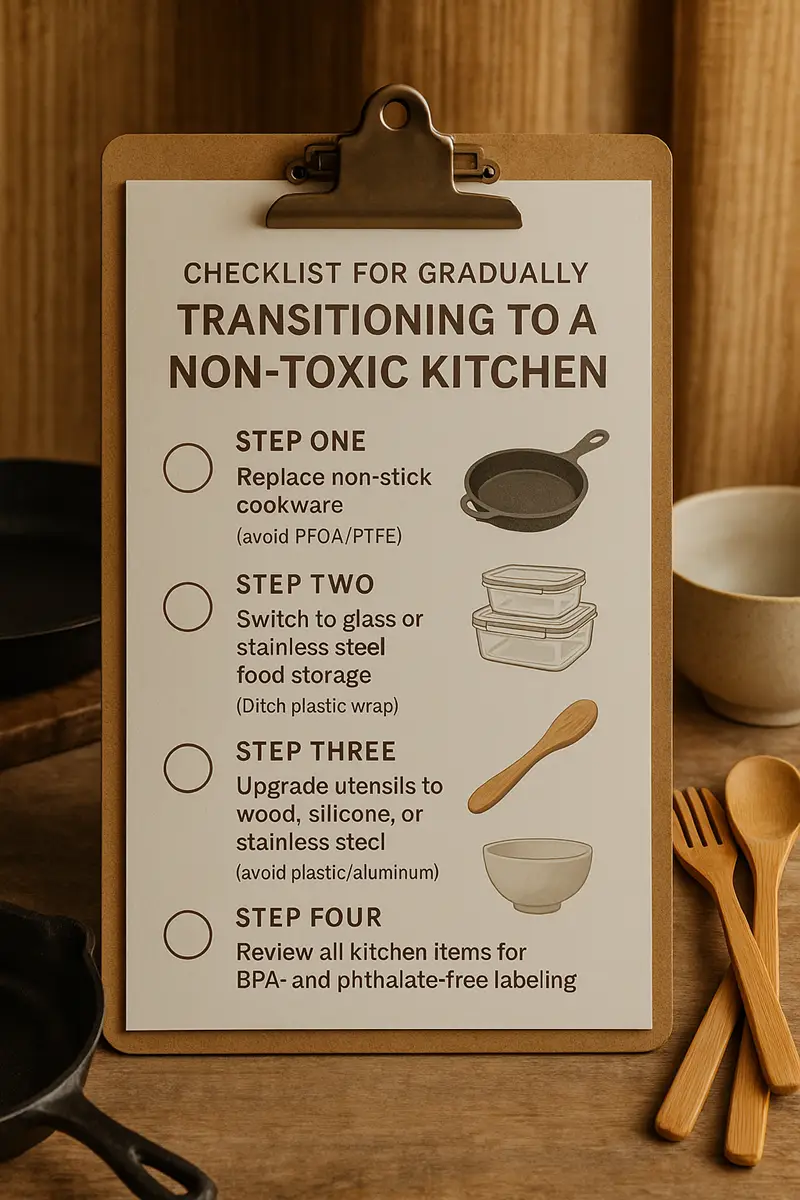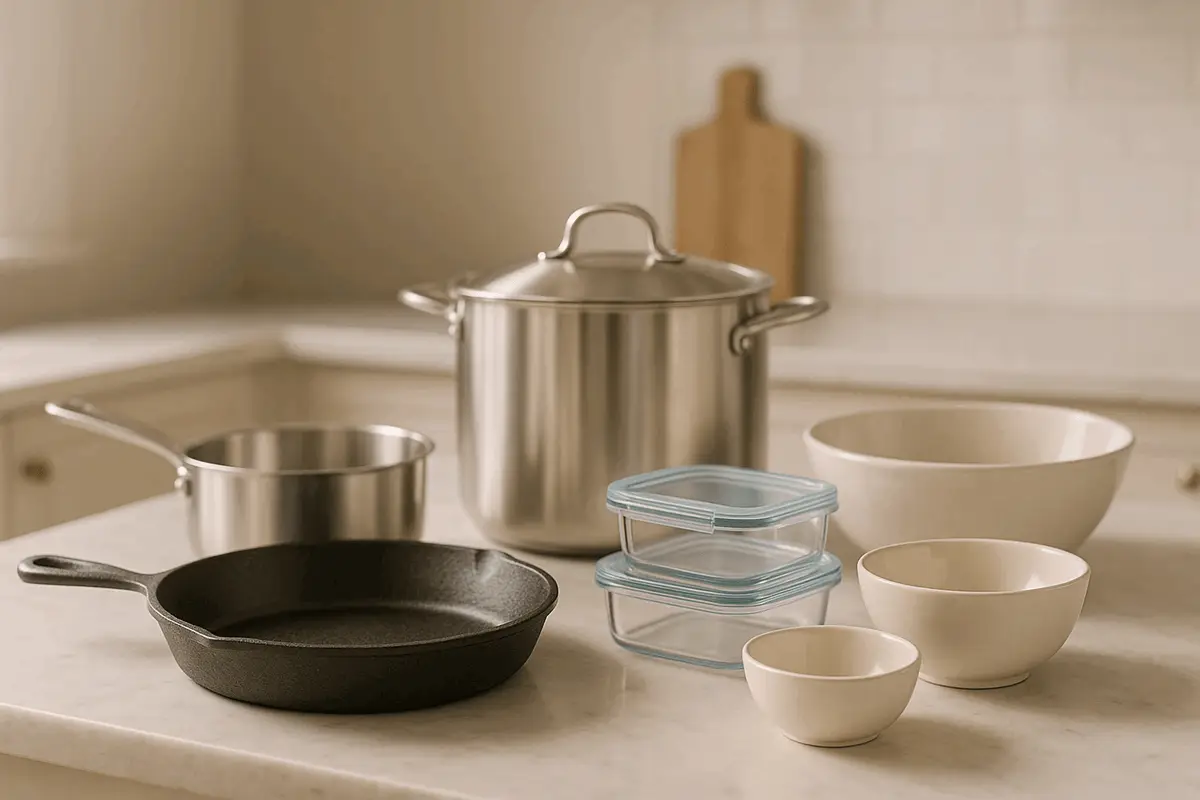Non-Toxic Kitchen Starter Kit 2025
Define Non-Toxic:
Non-toxic, in the context of kitchen items, refers to products that do not contain harmful chemicals or substances that can pose a risk to human health or the environment. Common toxic substances found in kitchen items can include heavy metals, phthalates, formaldehyde, and volatile organic compounds (VOCs). These chemicals can be released into the air or migrate into food during cooking and storage, leading to potential health risks. For example, non-toxic cookware is made from materials like stainless steel, cast iron, or ceramic, which are free from harmful coatings and additives.
The idea of non-toxicity extends to various kitchen items such as utensils, storage containers, cookware, and even cleaning supplies. Non-toxic products are often made from natural materials, are free from synthetic fragrances, and are manufactured without the use of harmful chemicals. This is crucial, as many kitchen items are used daily and can have a cumulative effect on our health over time.
To illustrate, many non-toxic brands promote products labeled as “BPA-free“ (Bisphenol A), which is a chemical often found in plastics and linked to health issues, including hormone disruption. By choosing non-toxic kitchen items, consumers can significantly reduce their exposure to such harmful substances, contributing to a healthier living environment.
Importance of Non-Toxic Products:
The importance of non-toxic products in the kitchen cannot be overstated, particularly when considering the substantial amount of time we spend in this space. The kitchen is a hub for food preparation, and the items we use can significantly impact our well-being. Studies have shown that prolonged exposure to harmful chemicals can lead to various health problems, including respiratory issues, allergic reactions, and even long-term effects like cancer and endocrine disruption.
For instance, opt for glass or stainless steel food storage containers instead of plastic ones to keep your food safe from chemical leaching. Non-toxic cookware also enhances the cooking experience by providing a safe surface that doesn’t introduce unwanted substances into the food. Additionally, non-toxic cleaning agents made from natural ingredients can effectively sanitize without leaving harmful residues.
Consumers are finding that the health benefits of reducing harmful chemicals extend beyond just physical well-being; they often experience increased peace of mind when they know their kitchen is free from toxic substances. To support this, research from the Environmental Working Group (EWG) highlights that cleaner air and reduced chemical exposure in the home environment contribute positively to mental health and overall quality of life.
Growing Awareness:
In recent years, there has been a significant shift toward greater awareness surrounding non-toxic lifestyles. Consumers are increasingly choosing organic produce, natural cleaning supplies, and non-toxic kitchen items as they become more informed about the potential hazards associated with conventional products. This growing awareness is part of a broader movement toward sustainability and environmental responsibility, as people recognize the impact their purchasing decisions have on both personal health and the planet.
This trend can be seen reflected in the rise of brands that specifically cater to the non-toxic market, offering everything from BPA-free cookware to eco-friendly cleaning products. Additionally, social media platforms and wellness blogs have contributed to the spread of information regarding the dangers of toxic chemicals, empowering consumers to make more informed choices. Online communities dedicated to non-toxic living have flourished, providing tips, product recommendations, and support for those transitioning to a healthier lifestyle.
One unique insight is that the non-toxic movement is not just a health trend; it symbolizes a cultural shift. It reflects a desire for transparency in product ingredients and a stronger connection to sustainable practices. As consumers increasingly demand accountability from manufacturers, this trend may reshape the market, leading to a long-term change in how kitchen items are produced and marketed.

Cookware, Utensils, Storage Solutions, and Cleaning Products
Ensuring a non-toxic kitchen starts with making thoughtful choices about cookware, utensils, storage solutions, and cleaning products. These elements play a crucial role in creating a safe environment for cooking and food preparation, impacting both health and sustainability. In this chapter, we will explore these essentials and recommend safer alternatives that are not just beneficial for your well-being but also for the planet.
Cookware
When it comes to cookware, opting for materials that are free from harmful chemicals is paramount. Here are three excellent alternatives:
- Stainless Steel: Known for its durability, stainless steel cookware is an excellent choice as it does not leach chemicals into food. It is also resistant to rust and corrosion, making it long-lasting. Look for high-grade stainless steel, such as 18/8, which contains 18% chromium and 8% nickel for a non-reactive cooking surface.
- Cast Iron: Not only does cast iron cookware provide exceptional heat retention and even cooking, but it also offers an iron supplement to your diet as trace amounts of iron are released into food while cooking. Properly seasoned cast iron can offer a natural, non-stick surface without the risks associated with synthetic coatings.
- Ceramic Pots: If you’re seeking a non-stick alternative, ceramic cookware is a fantastic option. Made from clay and natural minerals, ceramic pots do not contain harmful chemicals often found in traditional non-stick coatings, such as PFOA or PFOS. High-quality ceramic cookware is non-reactive and offers easy cleanup.
Utensils
Choosing the right utensils is equally essential in maintaining a non-toxic kitchen. Here are some recommendations:
- Wooden Utensils: Wooden spoons and spatulas are classic choices that are safe for non-stick cookware and are naturally antimicrobial. They are durable and won’t scratch the surface of your pots and pans, preserving their lifespan.
- Silicone Utensils: Silicone utensils are another safe and versatile alternative. They are heat-resistant, easy to clean, and do not leach harmful chemicals into your food. Selecting silicone kitchen tools that are BPA-free ensures you avoid toxic substances.
Storage Solutions
Proper food storage is critical for reducing waste and maintaining food safety. The materials you choose for storage containers can also impact your health. Glass and stainless steel containers are highly recommended over plastic for several reasons:
- Glass Containers: Glass is non-porous, which means it won’t absorb food odors or stains, and it can be easily cleaned in the dishwasher. Additionally, glass containers are microwave and oven-safe, making them versatile for meal prep.
- Stainless Steel Containers: Not only are they durable and long-lasting, but stainless steel containers are also non-toxic and recyclable. They are ideal for on-the-go meals and snacks, as they won’t leach chemicals into your food.
Cleaning Products
Maintaining a clean kitchen is vital for a non-toxic cooking environment. Traditional cleaning products often contain harsh chemicals that can end up in food surfaces. Here, we’ll identify some eco-friendly alternatives you can use:
- Vinegar and Baking Soda: These two household staples are powerful when combined. Vinegar can disinfect surfaces due to its acidity, while baking soda acts as an abrasive cleaner. This combination effectively cleans countertops, stovetops, and sinks without harmful residues.
- Essential Oils: Many essential oils, such as tea tree oil and lavender, possess natural antibacterial properties. Adding a few drops to your cleaning solution can enhance its effectiveness while leaving a pleasant scent.
- Eco-Friendly Brands: Consider using brands that focus on non-toxic, biodegradable ingredients. Look for certifications such as “Green Seal” or “EPA Safer Choice” for assurance that the products are safe for you and the environment.
Unique Insight While many are becoming more aware of the dangers of toxic cookware and cleaning supplies, a common oversight is neglecting the importance of maintaining those items properly. For instance, ensuring your cast iron cookware is seasoned correctly will extend its lifespan and efficiency, whereas poorly maintained cookware can lead to increased chemical leaching.
When considering a non-toxic kitchen starter kit, understanding the materials used in kitchen items is crucial. The importance of selecting safe materials cannot be overstated, as it directly affects our health and that of our families. Non-toxic kitchen items should be free from harmful chemicals such as BPA, phthalates, and lead. This is particularly relevant in kitchenware that comes into direct contact with food, like cookware, utensils, and food storage containers.
For cookwares, materials such as stainless steel, cast iron, glass, and food-grade silicone offer excellent durability and safety. Stainless steel, for example, is non-reactive, meaning it won’t leach chemicals into food—making it an excellent choice for pots and pans. Cast iron is another fantastic option that, when properly seasoned, can provide a non-stick surface without the use of synthetic coatings. Glass containers, on the other hand, are great for food storage; they don’t stain, don’t retain odors, and are free from toxins.
When evaluating kitchen items, certain certifications can assure consumers about their safety. When shopping for non-toxic kitchen products, look for certifications such as FDA approval, NSF International, or Greenguard Gold certification. These labels indicate that the products meet strict safety standards, ensuring they are free from harmful chemicals and safe for food contact.
In today’s market, several reputable brands stand out for their commitment to producing non-toxic kitchen items. Brands like GreenPan are well-regarded for their ceramic non-stick cookware, which is free from PFAS, PFOA, lead, and cadmium. Similarly, brands like Pyrex and Anchor Hocking offer high-quality glass storage solutions that are both durable and chemical-free. For utensils, brands such as OXO provide silicone kitchen tools that are free from BPA, making them an excellent choice for those looking to minimize plastic use in their kitchens. Additionally, brands like Lodge offer pre-seasoned cast iron cookware that can enhance flavor while remaining free of toxic coatings.
When comparing the costs of non-toxic kitchen items with traditional options, it’s essential to consider the value over the long term. Although the initial investment in non-toxic kitchenware may seem higher, these products often last longer and require less replacement than their traditional counterparts. For example, a high-quality stainless steel saucepan or cast iron skillet may come with a higher price tag than a non-stick pan, but the durability and safety make them a worthwhile investment. Over time, individuals may find that less frequent replacements lead not only to savings on purchases but also reduced waste, which contributes positively to the environment.
In conclusion, selecting non-toxic kitchen items entails a careful consideration of materials, certification, and brand reputation. By prioritizing these aspects, consumers can make informed choices that enhance their kitchen experience while ensuring their health and well-being. The combination of choosing durable products and aware spending not only allows for a safer cooking environment but also promotes sustainable living practices.
Gradual Transition to a Non-Toxic Kitchen
Making the shift to a non-toxic kitchen doesn’t have to feel overwhelming or daunting. A gradual transition can be an effective way to make this switch manageable while becoming informed about the products that will best suit your needs. Below is a structured approach that can help you replace conventional kitchen items step by step.
Step 1: Assess Your Current Kitchen Products
Before making any changes, take stock of the kitchen items you currently use. Check labels for toxic ingredients, particularly those containing harmful chemicals such as formaldehyde, phthalates, and BPA (Bisphenol A). Write down the items you want to replace, such as plastic containers, non-stick pans, conventional cleaners, and synthetic food wrap.
Step 2: Prioritize High-Impact Items
Next, focus on the kitchen items that have the greatest impact on your health and the environment. Start with food storage containers, as these will directly interact with your meals. Consider switching to glass or stainless steel containers instead of plastic ones, as they do not leach harmful chemicals into food.
Step 3: Replace One Item at a Time
Once you’ve identified high-risk products, replace them one at a time. For instance, if you are using a conventional all-purpose cleaner with harsh chemicals, you can switch to a natural vinegar-based cleaner as you run out of the conventional product. Alternatively, if you’re looking for a non-toxic cookware option, consider investing in stainless steel or cast-iron pans when you have the budget and need to replace existing ones.
Step 4: Explore DIY Cleaners and Food Storage Solutions
Part of your new kitchen might involve making your own non-toxic cleaners and storage solutions. A simple vinegar and baking soda mixture can be used as a powerful all-purpose cleaner, while essential oils like tea tree or lavender can provide added antimicrobial properties. For food storage, try wrapping your leftovers in beeswax wraps, which are reusable and biodegradable, thus reducing plastic waste.
Step 5: Seek Community Resources
You don’t have to go through this transition alone. Connect with local groups or online forums dedicated to healthy living, as they can offer invaluable support and product recommendations. Websites like Facebook have groups focused on non-toxic living that provide shared experiences and product reviews. Community members often share DIY recipes for various cleaners, body products, and cooking techniques that are eco-friendly. By approaching your transition gradually, you limit stress and are more apt to make informed choices. As you share your journey with friends or in community forums, you’ll find inspiration and encouragement to continue replacing conventional items in your kitchen.

FAQ Section: Non-Toxic Kitchen Products
1. What are non-toxic kitchen products?
Non-toxic kitchen products are those made from materials that do not leach harmful chemicals into food or the environment. This includes cookware, food storage containers, utensils, and cleaning supplies that are free from chemicals like BPA, phthalates, and heavy metals. For instance, stainless steel cookware and glass food storage containers are often deemed safe choices that do not contain harmful substances.
2. How can I identify non-toxic cookware?
Look for cookware labeled as stainless steel, cast iron, or ceramic. These materials are generally considered non-toxic. Additionally, certification from reputable organizations, such as the Environmental Protection Agency (EPA) or the USDA Organic seal, can provide assurance of the product’s safety. Avoid non-stick pans coated with polytetrafluoroethylene (PTFE) or perfluorooctanoic acid (PFOA) as these have been linked to health concerns.
3. Are all plastic kitchen items harmful?
Not all plastic kitchen items are harmful, but many can contain toxic chemicals. When purchasing plastic items, look for those labeled as “BPA-free” or “phthalate-free.” Additionally, plastics with recycling codes #1 (PET), #2 (HDPE), #4 (LDPE), and #5 (PP) are considered safer options. However, it is always advisable to use glass or stainless steel for food storage to minimize risk.
4. Can I use essential oils in my kitchen safely?
Essential oils can be used safely in the kitchen for cleaning and flavoring food, but caution is necessary. Not all essential oils are safe for ingestion, so it’s crucial to only use food-grade essential oils if you plan to add them to your cooking. Additionally, ensure that any essential oil cleaning products are labeled as food safe to avoid chemicals that could contaminate food surfaces.
5. Are eco-friendly cleaning products worth the cost?
Eco-friendly cleaning products are often more sustainable and safer for both health and the environment. While they may be slightly more expensive than conventional cleaning products, they typically use biodegradable ingredients that reduce environmental impact. Consider the long-term health benefits of using non-toxic products, particularly for households with children or pets.
6. Is there a difference between ‘natural’ and ‘non-toxic’ labeling?
Yes, there is a significant distinction between the terms ‘natural’ and ‘non-toxic.’ ‘Natural’ does not always mean that a product is free from harmful substances, as the term is not strictly regulated. In contrast, ‘non-toxic’ indicates that the product is safe for use without releasing harmful chemicals. Always verify product labeling and ingredient lists for peace of mind.






